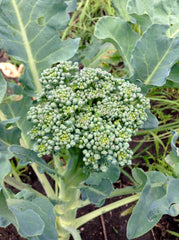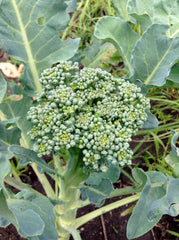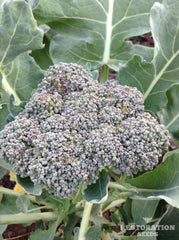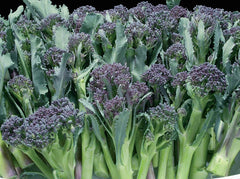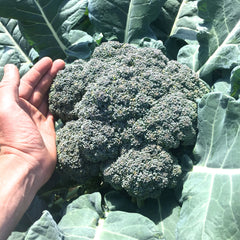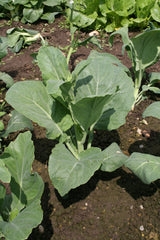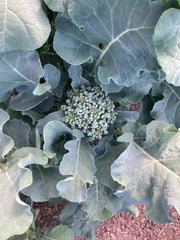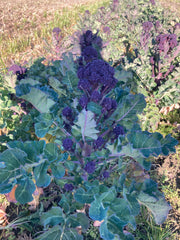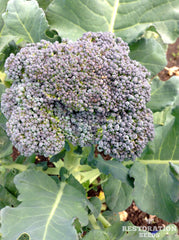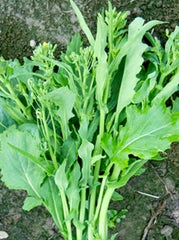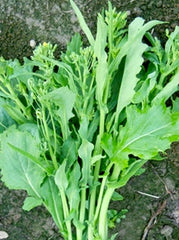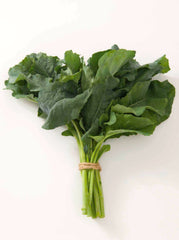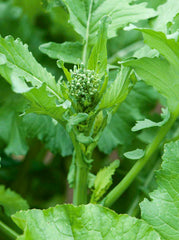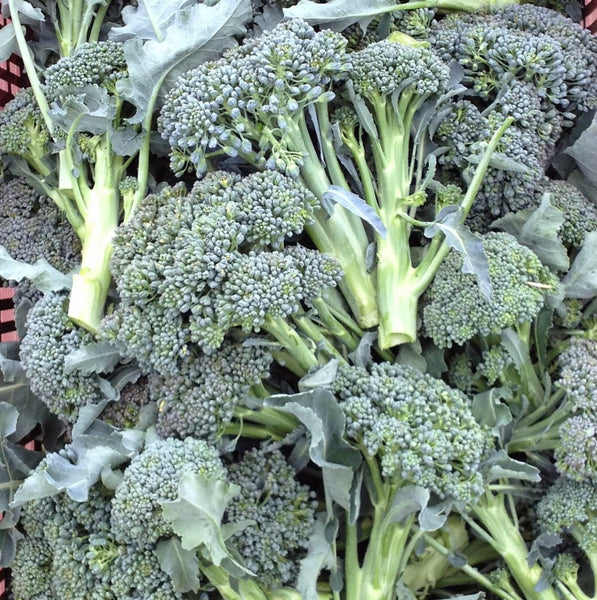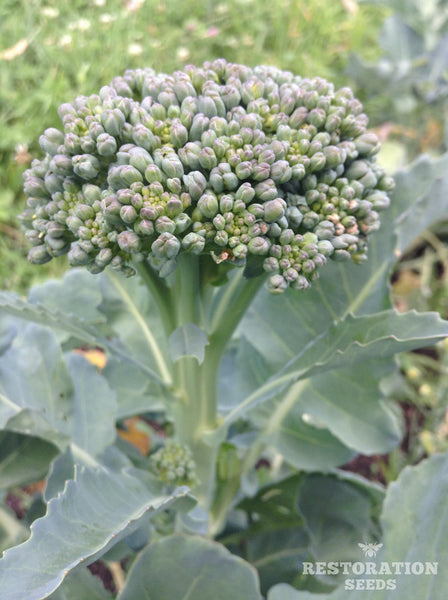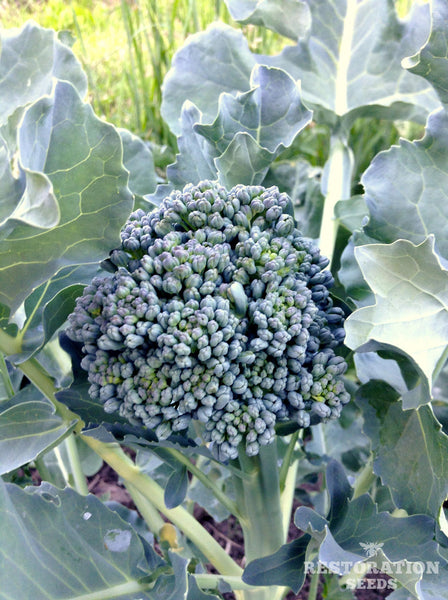Tender Early Green
Brassica oleracea italica
HOW TO GROW BROCCOLI
Start indoors 4-6 weeks before last frost and plant out 2 weeks before frost; or direct seed 2 weeks before last frost. For fall harvest, transplant 8–12 weeks before first frost. In a hoophouse, you can plant 2-3 later. We seed in March under cover, first of May in the open. We seed from July 1 to August 15 for fall harvest in zone 8b. Broccoli grows best in the 60s˚F so plant for best temperatures in your area. For seed in Zone 7b or warmer, direct sow in early January under Row cover. Soil pH 6.0-7.5. Hardiness zones 4-10. Biennial.
Days from maturity calculated from the date of seeding. Average 6,000-9,000 seeds per ounce. Average 58M seeds per acre. Federal germination standard: 75%. Usual seed life: 5 years. Isolation distance for seed saving: 1 mile.
Planting Depth 1/4-1/2”
Soil Temp. Germ. 65-75˚F
Days to Germ. 5-10
Plant Spacing 18-24”
Row Spacing 24-36”
Days To Maturity 60–70
Full Sun, Moist Well Drained
Days from maturity calculated from the date of seeding. Average 6,000-9,000 seeds per ounce. Average 58M seeds per acre. Federal germination standard: 75%. Usual seed life: 5 years. Isolation distance for seed saving: 1 mile.
Planting Depth 1/4-1/2”
Soil Temp. Germ. 65-75˚F
Days to Germ. 5-10
Plant Spacing 18-24”
Row Spacing 24-36”
Days To Maturity 60–70
Full Sun, Moist Well Drained
- 200 Seeds$4.10
- 2000 Seeds$15.50
- 1 Ounce$32.00
After several trials and two years of hard selection, Steve is ready to release this improved old favorite. It has proved itself to be superior in an extremely wide range of environments, from the high desert of southern Arizona to the foggy coast of California. While the nicely domed central head is not as large as...
After several trials and two years of hard selection, Steve is ready to release this improved old favorite. It has proved itself to be superior in an extremely wide range of environments, from the high desert of southern Arizona to the foggy coast of California. While the nicely domed central head is not as large as modern hybrids, it nonetheless offers multiple advantages. Uniform small heads, ideal salad size. After cutting the central head, the plant continues to produce abundant tasty side shoots for several months. In addition, the stems are very tender, which increases the amount of edible, delicious broccoli that may be harvested from each plant.
Taste trials demonstrate the superiority of this OP variety, and Steve is proud enough of his efforts to put his name on it! Tags: Harvest: Early, Color: Green, Specialty: Bolt Resistant, Season: Spring Fall, Certification: Organic.
Taste trials demonstrate the superiority of this OP variety, and Steve is proud enough of his efforts to put his name on it! Tags: Harvest: Early, Color: Green, Specialty: Bolt Resistant, Season: Spring Fall, Certification: Organic.
Learn More
Meet Your Farmer
We promote fair trade, organic practices and environmental responsibility throughout the Restoration Seeds supply chain. Below are the family farmers and seed suppliers who bring our open pollinated seeds to you.
Fifth Crow Farm
Certified Organic by CCOF
Seed grower since 2010


An open discussion about organic, open-pollinated, public domain, open source seed development in California. Hi, I’m Steve Peters, avid gardener, part-time farmer and serious seed advocate. I’m calling my new consulting business ‘Seed Revolution Now’.Having moved here six months ago from the Southwest made me realize just how amazingly abundant California truly is. This is the perfect place for growing many kinds of seeds by virtue of the climate, soil, and infrastructure. My professional focus has been on organic vegetable seeds. Unlike the commodity crops, the vegetable seed industry is highly segmented, with a multitude of specialty niches and markets. Therefore, there is a lot of opportunity for innovation with regards to breeding and marketing, which has enabled many smaller-scaled farmers to enter into this business.Vegetables are obviously important in California agriculture (~7.5 billion $ in 2011). The growers of all those crops purchase virtually all of their seed from one of a handful of large, private seed breeding companies, such as Vilmorin, Syngenta or Monsanto. All this proprietary seed is meant to principally serve mono-cultural, industrial farming systems.The good news is that we now have the capability to create an alternate seed industry that truly serves the needs of the smaller-scaled, ecologically based farms that exist in all of the unique bio-regions throughout the state. While there are a few successful organic seed farmers in California, there is a tremendous opportunity to grow this into something that significantly contributes to the seed needs of our region’s produce farmers.
The goal of Seed Revolution Now is to create a network of skilled seed farmers to grow and select for really robust, high quality genetic material through open-pollinated breeding, which I believe is superior to F1 hybrid breeding for long-term sustainability.
These varieties will be held in the public domain. This seed will remain “open source”, which means that it can always be used as breeding material, and subsequent new varieties can never be patented.
We farmers and advocates must come together and develop a comprehensive strategy to grow our business. I’d like your input on the following questions: Who are the farmers that need the seed? What specific varieties/crop types and genetic traits do they need? What will they need 5-10 years from now? Who currently are the seed farmers that could produce this seed? Who are the future seed farmers?
Let’s develop a guideline for each variety and crop type, including years required to go from breeder seed->stock seed->production seed, and identify the best farmers to grow each of these seed crops.
We can start by finding out what varieties, crops, and traits are most sought after. Here are the top fifteen fresh vegetable crops (in order) in gross sales in California: Lettuce, Broccoli, Carrot, Tomato, Celery, Cauliflower, Sweet Pepper, Garlic, Melon, Onion, Spinach, Watermelon, Sweet Corn, Chile Pepper, Cabbage. I hope to hear from folks who are interested in this aspect of food security. Together we can make a difference.
The goal of Seed Revolution Now is to create a network of skilled seed farmers to grow and select for really robust, high quality genetic material through open-pollinated breeding, which I believe is superior to F1 hybrid breeding for long-term sustainability.
These varieties will be held in the public domain. This seed will remain “open source”, which means that it can always be used as breeding material, and subsequent new varieties can never be patented.
We farmers and advocates must come together and develop a comprehensive strategy to grow our business. I’d like your input on the following questions: Who are the farmers that need the seed? What specific varieties/crop types and genetic traits do they need? What will they need 5-10 years from now? Who currently are the seed farmers that could produce this seed? Who are the future seed farmers?
Let’s develop a guideline for each variety and crop type, including years required to go from breeder seed->stock seed->production seed, and identify the best farmers to grow each of these seed crops.
We can start by finding out what varieties, crops, and traits are most sought after. Here are the top fifteen fresh vegetable crops (in order) in gross sales in California: Lettuce, Broccoli, Carrot, Tomato, Celery, Cauliflower, Sweet Pepper, Garlic, Melon, Onion, Spinach, Watermelon, Sweet Corn, Chile Pepper, Cabbage. I hope to hear from folks who are interested in this aspect of food security. Together we can make a difference.
Reviews
